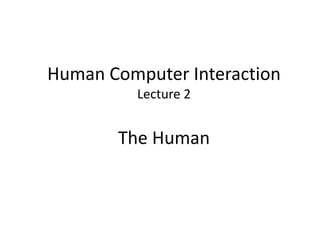
HCI lecture02
- 1. Human Computer Interaction Lecture 2 The Human
- 2. The Human • Think of human as an information processing system, which contains input/output, stores information and processes information • We will therefore consider three components of this system: input-output, memory and processing
- 3. The Eye - physical reception • mechanism for receiving light and transforming it into electrical energy • light is reflected from objects • images are focused upside-down on retina • retina contains rods for low light vision. Rods are responsible for vision in darkness. Approximately 120 million rods.
- 4. The Eye - physical reception • Retina also contains cones for colour vision. They are responsible for vision in light. • Cones are concentrated on fovea and rods are concentrated on retina • Blind spot contains neither rods nor cones. • Ganglion cells (brain!) detect pattern and movement
- 5. Design Focus • A user concentrating on the middle of the screen cannot be expected to read help text on the bottom line. • So if an error message is to be shown to user, what to do??? • Better use flashing error message • What about clever moving icons.
- 6. Interpreting the signal • Brightness – subjective reaction to levels of light – affected by luminance of object, which is the amount of light emitted by an object – Contrast is luminance of object and luminance of its background – visual acuity increases with luminance as does flicker. – High display luminance systems are seen to flicker even above 50 Hz.
- 7. Interpreting the signal (cont) • Colour – made up of hue, intensity, saturation • Hue is determined by the spectral wavelength of the light – Approximately 150 different hues can be discriminated by the average person • Intensity is the brightness of color • Saturation is the amount of whiteness in color – Cones are sensitive to colour wavelengths. Three types of cones (red, green and blue) – blue acuity is lowest, because only 3-4% of the fovea is occupied by cones which are sensitive to blue light – 8% males and 1% females colour blind
- 8. Interpreting the signal (cont) • Our expectations affect the way an image is perceived. • Context is used to resolve ambiguity • However, Optical illusions sometimes occur due to above factors
- 9. Optical Illusions the Ponzo illusion the Muller Lyer illusion
- 10. Reading • Several stages: – visual pattern perceived – decoded using internal representation of language – interpreted using knowledge of syntax and semantics • Reading involves saccades(jerky movements) and fixations • Perception occurs during fixations • Word shape is important to recognition • Negative contrast (dark character on a light screen) improves reading from computer screen
- 11. Design Focus • Standard font sizes of 9 to 12 are equally legible, given proportional spacing between lines. • Similarly line lengths of between 2.3 and 5.2 inches (58 and 132 mm) are equally legible. • Nevertheless, reading from a computer screen is slower than from a book. However, this fact can be controlled by careful design of textual interfaces.
- 12. Hearing • Sound can convey a remarkable amount of information • Provides information about environment: distances, directions, objects etc. • Physical apparatus: – outer ear – protects inner and amplifies sound – middle ear – transmits sound waves as vibrations to inner ear – inner ear – chemical transmitters are released and cause impulses in auditory nerve • Sound – pitch – sound frequency – loudness – amplitude – timbre – type or quality
- 13. Hearing (cont) • Humans can hear frequencies from 20Hz to 15kHz – less accurate distinguishing high frequencies than low. • Auditory system filters sounds – can attend to sounds over background noise. – for example, the cocktail party phenomenon. • Sound could be used extensively in interface design to convey information about the system state
- 14. Touch • Provides important feedback about environment. • May be key sense for someone who is visually impaired. • Stimulus received via receptors in the skin: – thermoreceptors – heat and cold – nociceptors – pain – mechanoreceptors – pressure • Some areas more sensitive than others e.g. Fingers and hair
- 15. Movement • Fitts' Law describes the time taken to hit a screen target: Mt = a + b log2(D/S + 1) where: a and b are empirically(gained by means of observations) determined constants Mt is movement time D is Distance S is Size of target targets as large as possible distances as small as possible
- 16. Memory There are three types of memory function: Sensory memories Short-term memory or working memory Long-term memory
- 17. Sensory Memory • Buffers for stimuli received through senses – iconic memory: visual stimuli – echoic memory: aural stimuli – haptic memory: touch stimuli • Examples: Move your finger fastly before you, “sparkler” trail Continuously overwritten • Information is passed to STM by attention
- 18. Short-term memory (STM) • What is the result of 35 * 6??? • Scratch-pad for temporary recall – rapid access – rapid decay – limited capacity - 7± 2 Principle
- 19. Examples 21234827849320245456 21234 482784 932024 5456 03323583302 0332-35-83-302 ATM Card example